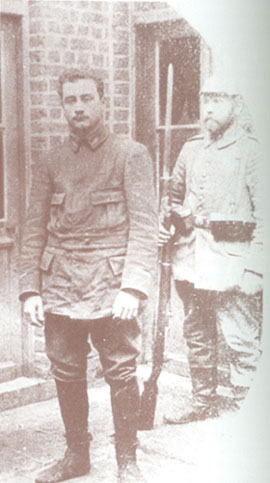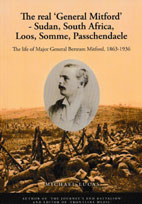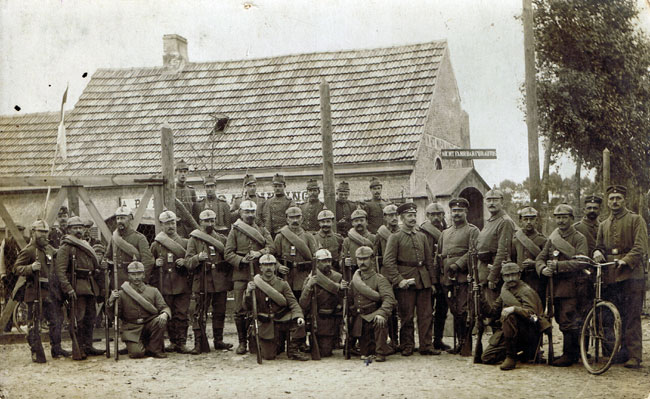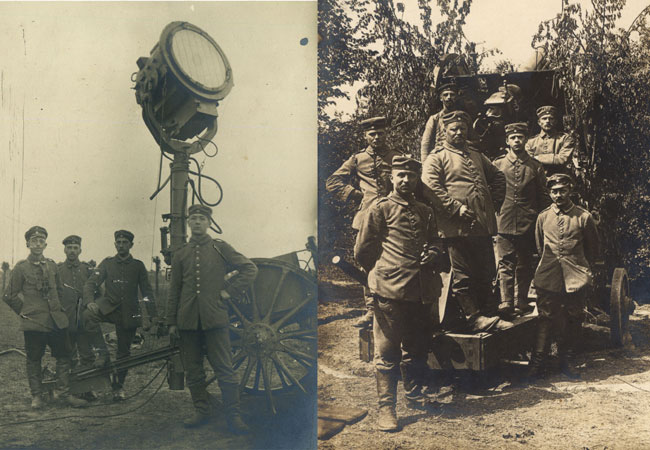The men who shot down Garros
While not technically an ace (with only three confirmed aerial victories at this time), Sous-lieutenant Roland Garros of Escadrille MS26 had certainly presented a uniquely serious threat to German aviators.

On 1st April he had achieved the first ever aerial 'kill' with a machine-gun fired forward through the propeller, using a system of deflector plates of his own design fitted to the blades. With this (at the time) unique advantage he could have been forgiven for thinking himself invincible when he attacked Lendelede railway station on the 18th.
With his engine disabled by ground fire, he made an emergency landing near Hulste and was soon run to ground by a Württemberg cavalry patrol. Although he had managed to set his aircraft on fire, the deflector device was intact enough to be salvaged and understood. It would however soon be superseded by Fokker's synchronisation gear (which far more elegantly prevented the gun from firing at the moment when the blade passed in front of it). Garros himself would eventually escape from a POW camp in February 1918 and return to action, only to be shot down and killed on 5th October 1918 after achieving a fourth and final aerial victory.
The credit for shooting down Garros was claimed by two different units, both of which would be acknowledged and rewarded. Having only had the chance to hear from one of them, Generalmajor Kaden supports the claim of 1. Kompagnie / Landsturm-Infanterie-Bataillon 'Wurzen' XIX.9. Although this is one of only two Saxon Landsturm infantry battalions with a full published history, it has remarkably little to say about what was unquestionably its most significant achievement:
The Bahnschutzwache [railway guard] Lendelede (1. Komp.) shot down the French flier Garros and took him prisoner (Feldwebelleutnant Schlenstedt, Landsturmmann Arnold I and Landsturmmann Brömme received a cash reward and the Iron Cross 2nd Class).
The other claim is more detailed and technically more credible (if less entertaining than the idea of some old Saxon militiamen downing a celebrity aviator using - presumably - a mere machine-gun). The unit in question was the Fliegerabwehrzug or Fliegerabwehrbatterie (anti-aircraft section or battery) of Reserve-Feldartillerie-Regiment Nr.54, formed at the beginning of April and commanded by Leutnant der Landwehr (later Oberleutnant) Egon Kienzle. Though it was initially based at Ledegem, Leutnant der Landwehr Prof. Karl Ramshorn of RIR 245 states (in a colourful account of his time as regimental billeting officer which appears in full in For King and Kaiser) that the well-liked Württemberg artillery officer had two guns set up near the Waterdamhoek crossroads, making him Ramshorn's close neighbour.
According to the regimental history of Oberst a.D. Klotz (Das Wurttembergische Reserve-Feldartillerie-Regiment Nr.54 im Weltkrieg 1914-1918):
Using their fast aircraft fitted with machine-guns, the enemy had shot down six of our eighteen fliers, since they only had one fighter aircraft at their disposal. On the 18th the 5. Batterie succeeded in shooting down Garros, known at the time as the most dangerous French aviator, who was then captured.
The battery located at rest in Moorsele was always required to provide one piece as an anti-aircraft gun, at the disposal of the Kommando under Oberleutnant Kienzle which was based there. Usually the entire resting battery would gather as spectators.
One evening an enemy flier unexpectedly appeared, eagerly aiming for the rear area. Immediately fire was opened and soon the plane was encircled [by shellbursts], shot after shot followed at the highest rate of fire. But all in vain, for the plane seemed invulnerable. The range grew ever greater and finally the leader's command rang out "halt, cease fire". Then "crash" another shot went off and triggered a frightful tirade from the leader about this poor fire discipline. Every possible punishment was promised. Then suddenly a gunner called: "Herr Oberleutnant, he's falling!" Everyone spun around and indeed, the last inadvertent shot had nevertheless still found its target. The flier could be seen descending in a steep glide. With the cry "a cask of beer for the whole crew tonight!" the leader left the crew to accept the somewhat contradictory judgement. When it subsequently turned out that the renowned Garros had fallen into our hands, there were even awards.
Above left: A 60cm carriage-mounted floodlight from Reserve-Scheinwerfer-Zug Nr.27 (the corps searchlight platoon of XXVII. Reservekorps) on airfield defence duty behind the front.
Above right: Saxon field artillerymen of XXVII. Reservekorps (either RFAR 53 or I. Abt. / RFAR 54) with a typical early anti-aircraft gun. A standard 7.7cm FK96 n.A. field gun has been mounted (complete with trail and wheels) on a 'Schnetzler-Sockel', a more elaborate mass-produced replacement for the first wave of improvised turntables.
In early 1915 many field artillery regiments were expected to improvise their division’s anti-aircraft defence with the weapons available to them, just as they were later expected to improvise its anti-tank defence.







